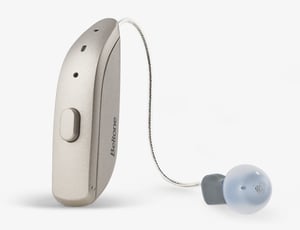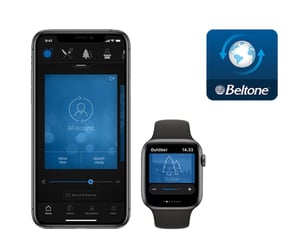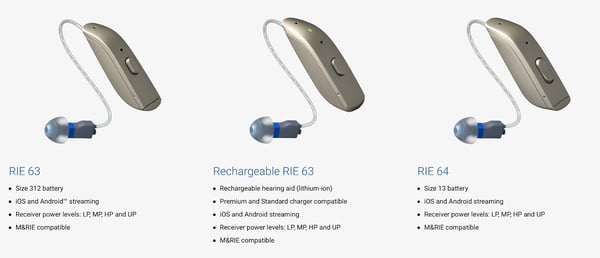Time to Read: 7 minutes
by Pauline Primrose-Heaney
When it comes to hearing aid manufacturers, many people in Australia may be less familiar with Beltone.
Founded in 1940 in Chicago, Beltone now has an international presence, but is represented differently in different countries. In Australia, Beltone is allied with ReSound, a name more people are likely to be familiar with.
In fact, it’s fairly common for more than one hearing aid brand to be owned by the same parent company. Think of Sonova (Phonak, Unitron, Hansaton), Demant (Oticon, Bernafon, Sonic Innovations), and WS Audiology (Signia, Widex, Rexton).
Beltone and ReSound
While some have chosen to feature one manufacturer as a premium, or “A” brand, manufacturer, ReSound has taken a different approach with Beltone. Beltone, like ReSound, is considered a premium brand but is only available to independent hearing clinics. Think of it as a boutique brand of hearing aid.
With this promise, Beltone offers its independent clinics more intensive product training and support, so that the clinics that offer its hearing aids have clinicians that have had very hands-on training and, hopefully, a more in-depth understanding of the product and how to optimise it for a hearing aid wearer.
So how does Beltone differ from ReSound?
Both manufacturers actually offer the same hearing aid features in their hearing aids (although they give these features different names); in fact, Beltone Amaze is technically the same product as ReSound LiNX Quattro, albeit in a different shell so they look different.
This will all change in December 2020 when ReSound releases its newest hearing aid - ONE, which will have the same features and same housing as the Beltone Imagine, which was released in October 2020. So the advantage of Beltone now comes down to having the latest technology available sooner, with clinicians that are better trained to fit the product, while also supporting an independent clinic.

The most stand-out new feature available with the launch of Beltone Imagine is actually the receiver (the part that goes in your ear).
While Beltone offer its conventional receivers in varying power levels, they have also introduced the M&RIE (Microphone and Receiver-In-Ear). M&RIE is only available in a moderate power receiver, so is suitable for a mild to moderately-severe hearing loss. What makes M&RIE innovative is the in-built microphone. So a hearing aid fit with a M&RIE will effectively have 3 microphones. The benefits of M&RIE are:
- Better localisation
- Better wind noise reduction
- More natural sound quality
- Improved hearing in noise (up to 2 dB signal-to-noise ratio improvement) compared to traditional directional microphone systems
But be advised: in order to accommodate a microphone, the size of the M&RIE is larger than most standard or moderate power receivers, so may not suit very small ear canals. However, M&RIE can be fit to some custom mould styles as well.
The Crosslink Directionality 3 program
Beltone Imagine also introduces a new automatic program called Crosslink Directionality 3. When fit with a M&RIE, it incorporates the existing two microphones on the hearing aid along with the M&RIE. It can automatically transition between 3 modes, depending on the acoustic environment:
- Spatial Cue Preservation - this is essentially an omnidirectional setting. If using M&RIE, the hearing aid will use all 3 microphones to create as natural a sound quality as possible and provide the localisation and wind reduction benefits offered by M&RIE. If using a conventional receiver, then the hearing aids use Personal Sound ID, which is a feature that tries to restore the natural advantages that the ear itself provides for localisation.
- Binaural Listening - this setting activates when the acoustic environment becomes more challenging. Depending on the direction the speech and noise are coming from, one hearing aid stays in omnidirectional mode while the other switches to directional mode using binaural weighted beamforming. This is a feature that has been offered by Beltone and ReSound for a number of years now. This approach helps to improve the signal-to-noise ratio while still providing awareness of what’s going on beside the hearing aid wearer. This feature works well in group settings where the hearing aid wearer is trying to hear speech in front as well as beside them (like in a restaurant scenario). It relies on split band directionality so that the sound stays balanced between the two hearing devices even though they’re operating differently.
- Speech Intelligibility - this setting is designed for the most challenging noise environments (where even people with normal hearing may struggle). Both hearing devices switch to binaural weighted beamforming mode and take into account the direction where the noise is coming from. It uses split band directionality so that there is still awareness of other surrounding noises rather than cutting the wearer off from these sounds.
Introducing Ultra Focus
The other new feature introduced in Beltone Imagine is Ultra Focus.
Ultra Focus is designed to be a dedicated manual program in the hearing aid that is actually similar to the Speech Intelligibility setting in Crosslink Directionality 3.
It can offer a 1.5 dB signal-to-noise ratio improvement over CrossLink Directionality 3 when noise is louder on one side. Ultra Focus narrows the focus of the hearing aid, so its benefit is in very challenging noise environments where the hearing aid wearer is trying to focus on a conversation with one speaker in front of them only.
Streaming Capabilities
As with their previous hearing devices, Beltone Imagine is Made for iPhone, which means that it offers direct streaming from iOS devices, but also offers direct streaming from select Android devices (you can find a list of compatible devices here). So you can continue to enjoy streaming phone calls, GPS, radio, music, podcasts, audiobooks and more with the upgraded audio streaming in the Beltone Imagine which eliminates connection delays.
For those wanting streaming capabilities but don’t have a compatible Smartphone, the Phone Link 2 accessory works as an intermediary device. In fact, there is a range of accessories available to suit those who need more assistance in managing their hearing aids or getting the most of our their hearing aids:
- Phonk Link 2 (for streaming between a Bluetooth-enabled device and the hearing aids)
- TV Link 2 (for streaming between the TV and the hearing aids)
- Remote Control (basic remote control for the hearing aids)
- Remote Control 2 (remote control for the hearing aids with more advanced functionality)
- myPAL micro (remote microphone with directional microphones)
- myPAL Pro (all the features of the myPAL micro with a motion sensor to switch modes based on its position)

Beltone Smartphone App
Beltone Imagine works with the freely-available Smartphone app, Beltone HearMax, which connects your hearing aids to iOS or Android devices. It has the basic functionality of increasing and decreasing hearing aid volume and changing programs, but also offers features such as Sound Enhancer and Speech Focus settings for those who want more advanced functionality.

The other great feature available in the HearMax app is remote support - Beltone offers both synchronous and asynchronous remote support options:
- Synchronous adjustments are live adjustments, where you have an appointment with your clinician and video call via the app so that your clinician can connect to your hearing aids remotely and make adjustments to them in real-time.
- Asynchronous adjustments allow you to request support at any time, and once our clinician receives the request, they can send you new settings to upload into your hearing aid at your convenience - no appointment required. All you need to do is use the HearMax app to send a
- request. Once new settings are received, you can upload and select whether you would like to keep the new settings or revert to the previous settings and send another request for further adjustments.
Beltone Imagine is currently available in 3 receiver-in-canal options (312 battery, 13 battery and lithium-ion rechargeable), and ushers in a completely new housing design, which is surprisingly comfortable to wear as well as fairly discreet behind the ear. It actually sits low behind the ear for less visibility and the diagonal design helps to optimise the hearing aid performance. The rechargeable and size 13 battery options are fairly comparable in size, and the size 312 battery option is slightly slimmer.
Beltone Imagine is available in 4 technology levels - 17, 9, 6, and 4.


